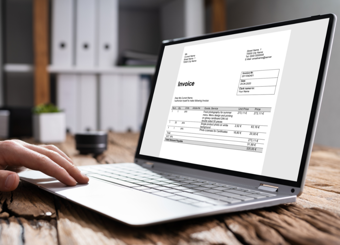Streamline Month and Year-End Closing
Anyone working in finance knows that closing the books for the month, quarter, and especially the year is critical to ensure the organization’s financials are accurate, up to date, and reported to all internal, as well as external, stakeholders. Despite improvements in efficiency from following best accounts payable practices and using an automated accounts payable process, the month-end close process still causes considerable stress. Over 75 percent of AP teams report processing more invoices in the most recent quarter, leading to setbacks and burnout.
During the month and year-end closing process, accounts payable professionals are tasked with reporting outstanding vendor invoices, such as invoices received but not yet posted in the ERP or finance system, to ensure accruals are booked accurately and cash flow forecasts updated. With a full or partly manual and paper-based AP process, this can be a complicated and highly time-consuming task. Gathering the information needed from various sources including paper invoices, spreadsheets, and systems while trying to respond to inquiries from different internal functions as well as vendors can easily become an impossible task. This statement is especially true for those finance professionals who are trying to do all of these functions by hand.
There’s a better way. Streamline the entire process. Soon account reconciliation and month and year-end closing procedures will be easy to handle and stress-free, which provides a myriad of benefits for remote employees. Now the C-suite and AP department can tackle month and year-end closing anytime and anywhere in a fraction of the former time while still following best accounts payable practices.
Access the Data You Already Own
The value of your AP invoice data is in collecting it and converting that raw data into meaningful reports. The trouble is, it’s most likely buried in the manual and paper-based processes of your AP invoice workflow. You may even have some level of digital workflow and/or automation in place already for AP, but if the systems are not robust enough, or if there’s still some level of manual processes, getting accurate visibility can still be quite painful to do.
The key is investing in the best accounts payable processes to transform the data you already own into something valuable. There are a few things to consider when vetting a new AP automation software to ensure it provides the reporting capability needed to improve the month and year-end closing procedures:
-
Will the tool help get rid of paper invoices for good? When you have a process with paper invoices, the valuable data on those pieces of paper gets shuffled into desk drawers and filing cabinets.
-
Can the tool provide real-time reporting to ensure an accurate picture of the organization’s financials at any time?
-
Can the tool offer ready-to-use reports to support month and year-end closing procedures as well as the ability to build custom reports based on the organization’s needs?
Provide the Relevant Data to the Right Stakeholders
Traditionally the CFO and finance team use data from the ERP to report on financial metrics. For this reason, it is imperative that the AP automation solution has solid integration with the ERP system. But it’s also important to note that the right AP automation solution can provide up-to-date invoice data that is not yet available in the ERP, and that will help business leaders get the full picture of the company’s liabilities. It can also provide visibility of early payment discount opportunities that can generate significant savings for the organization. The right AP automation solution will enable you to provide your CFO with accurate data to support accrual reporting, cash flow forecasts, financial audits, and discount opportunities.
When it comes to providing data for procurement, spend visibility is critical, and that includes purchase order data for direct and indirect spend. Procurement deals with after-the-fact liabilities in the form of expense invoices that need approval. However, there are solutions in place to shift those to a pre-approved model whereby purchase requisitions lead to the generation of purchase orders for indirect spend, allowing for control and visibility. Concerning contract performance, procurement can also look to their AP solution to see what stage of payment their existing contracts are in, and the proportion of spend per contract.
What is the difference between a month-end and a year-end close? Visibility matters
Managers who are responsible for a budget line or cost center may play an essential role in the processing of supplier invoices but often lack visibility of the overall AP process. Their role in handling invoice approvals and deviation management – often the steps of the AP process that delay the total processing lead-time – are usually not prioritized tasks and often end up at the bottom of their to-do list.
It’s worth a mention that a modern accounts payable process can help managers complete their part of the AP process more efficiently and faster with, for example, a user-friendly mobile tool and simplified deviation management functionality. In addition, since all invoices are collected in a digital tool, budget holders can easily search for supplier invoices to retrieve payment status and pull consolidated reports to gain visibility into outstanding invoices and actual spend per cost center.
Transform AP to a Critical Center of Business
It is clear that accounts payable plays an important role in the month and year-end procedures, as they hold much of the data that is crucial to close the books in time, with the correct numbers. There are still a lot of manual, semi-manual, and paper-based processes out there disabling AP, and the rest of the organization, to really streamline accounts payable and leverage the value of the invoice data. However, CFOs recognize the challenge, and a recent survey revealed over 92 percent of them are focused on digitizing AP processes within the next year.
Organizations that invest in modern and robust AP tools will benefit from better service to the business. Following current accounts payable best practices also help transform AP from a traditional back-office function to a critical business partner that helps drive the business forward.





